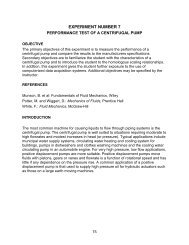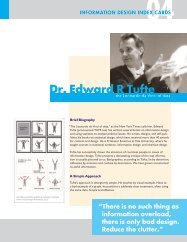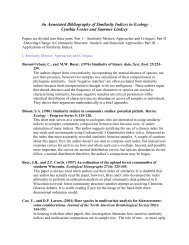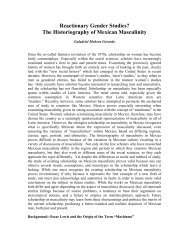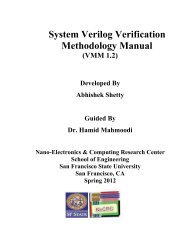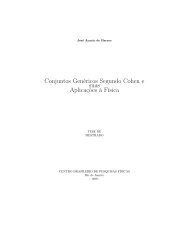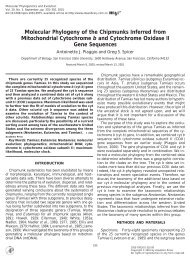Knowledge, Wine, and Taste: What good is knowledge (in ... - Sfsu
Knowledge, Wine, and Taste: What good is knowledge (in ... - Sfsu
Knowledge, Wine, and Taste: What good is knowledge (in ... - Sfsu
You also want an ePaper? Increase the reach of your titles
YUMPU automatically turns print PDFs into web optimized ePapers that Google loves.
<strong>Knowledge</strong>, <strong>W<strong>in</strong>e</strong>, <strong>and</strong> <strong>Taste</strong>:<br />
<strong>What</strong> <strong>good</strong> <strong>is</strong> <strong>knowledge</strong> (<strong>in</strong> enjoy<strong>in</strong>g w<strong>in</strong>e)?<br />
Kent Bach<br />
kbach@sfsu.edu<br />
http://onl<strong>in</strong>e.sfsu.edu/~kbach<br />
Philosophy <strong>and</strong> <strong>W<strong>in</strong>e</strong>: from science to subjectivity<br />
10th December 2004, Senate House, University of London<br />
THE QUESTION: I am ask<strong>in</strong>g a very specific question: what <strong>good</strong> <strong>is</strong> <strong>knowledge</strong> about<br />
w<strong>in</strong>e when it comes to enjoy<strong>in</strong>g the experience of tast<strong>in</strong>g a w<strong>in</strong>e? Can <strong>knowledge</strong>,<br />
about w<strong>in</strong>e <strong>in</strong> general or about the specific w<strong>in</strong>e you’re dr<strong>in</strong>k<strong>in</strong>g, help you enjoy<br />
that w<strong>in</strong>e? Can such <strong>knowledge</strong> even make the w<strong>in</strong>e taste better? Assum<strong>in</strong>g you<br />
have a basic lik<strong>in</strong>g for w<strong>in</strong>e, have a normal sensitivity to aromas <strong>and</strong> flavors, <strong>and</strong><br />
know how to expose the qualities of a w<strong>in</strong>e to the responsiveness of your senses,<br />
how, if at all, can <strong>knowledge</strong> about a particular w<strong>in</strong>e affect your enjoyment of it?<br />
Can it enhance your pleasure or even, on occasion, detract from it? Or, rather, does<br />
it provide its own k<strong>in</strong>d of pleasure, cognitive or even <strong>in</strong>tellectual pleasure, d<strong>is</strong>t<strong>in</strong>ct<br />
from the pleasure of tast<strong>in</strong>g?
<strong>Knowledge</strong>, <strong>W<strong>in</strong>e</strong>, <strong>and</strong> <strong>Taste</strong>:<br />
<strong>What</strong> <strong>good</strong> <strong>is</strong> <strong>knowledge</strong> (<strong>in</strong> enjoy<strong>in</strong>g w<strong>in</strong>e)?<br />
Kent Bach<br />
It’s a bit awkward for me to talk about philosophy <strong>and</strong> w<strong>in</strong>e. Even though I’m very<br />
analytical <strong>in</strong> philosophy <strong>and</strong> <strong>in</strong> all but one of my other passions, I’m not very<br />
analytical about w<strong>in</strong>e. I talk a lot of philosophy <strong>and</strong> I dr<strong>in</strong>k a lot of w<strong>in</strong>e, but I don’t<br />
do aesthetics, the sort of philosophy that’s relevant to talk<strong>in</strong>g about w<strong>in</strong>e, <strong>and</strong> I don’t<br />
talk a lot about w<strong>in</strong>e itself, even though I dr<strong>in</strong>k it almost nightly <strong>and</strong> have<br />
accumulated a great many bottles of it, too many <strong>in</strong> fact. Except at d<strong>in</strong>ners <strong>and</strong><br />
tast<strong>in</strong>gs, I don’t need to talk about w<strong>in</strong>e: I don’t make it, market it, sell it, score it, or<br />
write about it. In fact, I’m not very <strong>good</strong> at talk<strong>in</strong>g about w<strong>in</strong>e. I don’t write tast<strong>in</strong>g<br />
notes, <strong>and</strong> I can’t say I get all that much out of professional tast<strong>in</strong>g notes — I<br />
certa<strong>in</strong>ly can’t tell from read<strong>in</strong>g one what the w<strong>in</strong>e tastes like. I’m keen to try w<strong>in</strong>es<br />
of all sorts, <strong>and</strong> for me there’s no substitute for tast<strong>in</strong>g them myself. I recommend<br />
w<strong>in</strong>es to people, but the only way I know to justify a recommendation <strong>is</strong> to pour<br />
them a glass. So, despite my reluctance to talk about w<strong>in</strong>e, here I am today.<br />
Before tak<strong>in</strong>g up my question, a brief autobiographical note. Until 1993 I had no<br />
<strong>in</strong>terest <strong>in</strong> w<strong>in</strong>e. In my ignorance <strong>and</strong> <strong>in</strong>experience, I had no idea why other people<br />
were passionate about it, not only passionate about dr<strong>in</strong>k<strong>in</strong>g it but obsessed with<br />
know<strong>in</strong>g about it. Then th<strong>is</strong> changed suddenly, on one autumn even<strong>in</strong>g <strong>in</strong><br />
Ga<strong>in</strong>esville, Florida, of all places. I was dragged to a tast<strong>in</strong>g of w<strong>in</strong>es from St.<br />
Emilion. The group bl<strong>in</strong>d-tasted, described, <strong>and</strong> numerically rated eight w<strong>in</strong>es, most<br />
of which I enjoyed immensely. Despite my ignorance <strong>and</strong> <strong>in</strong>experience, my<br />
numerical rat<strong>in</strong>gs were all very close to the consensus of the group. That was a<br />
revelation to th<strong>is</strong> w<strong>in</strong>e heathen: I was conv<strong>in</strong>ced that there was someth<strong>in</strong>g I’d been<br />
m<strong>is</strong>s<strong>in</strong>g. The cl<strong>in</strong>cher was the mystery w<strong>in</strong>e, also wrapped <strong>in</strong> a paper bag, but not<br />
part of the regular tast<strong>in</strong>g. It was a 1975 Cheval Blanc, not the greatest of v<strong>in</strong>tages,<br />
2
as I would later learn, but more than <strong>good</strong> enough to make me a w<strong>in</strong>e convert. Now<br />
I began to see the light or, rather, to sniff <strong>and</strong> taste it.<br />
Zero<strong>in</strong>g <strong>in</strong> on the question<br />
I am ask<strong>in</strong>g a very specific question: what <strong>good</strong> <strong>is</strong> <strong>knowledge</strong> when it comes to<br />
enjoy<strong>in</strong>g the experience of dr<strong>in</strong>k<strong>in</strong>g a w<strong>in</strong>e? Can <strong>knowledge</strong>, about w<strong>in</strong>e <strong>in</strong> general<br />
or about the specific w<strong>in</strong>e you’re dr<strong>in</strong>k<strong>in</strong>g, help you enjoy the taste of that w<strong>in</strong>e?<br />
Can such <strong>knowledge</strong> even make the w<strong>in</strong>e taste better? The question <strong>is</strong> not <strong>in</strong>tended<br />
to apply to people completely new to w<strong>in</strong>e <strong>and</strong> without any experience at tast<strong>in</strong>g it.<br />
I am ask<strong>in</strong>g it about people who have a basic lik<strong>in</strong>g for w<strong>in</strong>e, have a normal<br />
sensitivity to aromas <strong>and</strong> flavors, <strong>and</strong> know how to expose the qualities of a w<strong>in</strong>e to<br />
the responsiveness of their senses. Given that, how, if at all, can <strong>knowledge</strong> about a<br />
particular w<strong>in</strong>e affect your enjoyment of it? Can it enhance your pleasure? Or,<br />
rather, does it provide its own k<strong>in</strong>d of pleasure, cognitive or even <strong>in</strong>tellectual<br />
pleasure, which accompanies the pleasure of tast<strong>in</strong>g? To put the question differently,<br />
<strong>is</strong> the difference between the pleasure experienced by a conno<strong>is</strong>seur <strong>and</strong> an non-<br />
expert w<strong>in</strong>e enthusiast purely cognitive or at least partly sensory?<br />
The specific question I’m ask<strong>in</strong>g does not concern the many other th<strong>in</strong>gs that<br />
<strong>knowledge</strong> about w<strong>in</strong>e <strong>is</strong> <strong>good</strong> for, such as mak<strong>in</strong>g w<strong>in</strong>e, sell<strong>in</strong>g it, <strong>and</strong> writ<strong>in</strong>g<br />
about it, <strong>and</strong> underst<strong>and</strong><strong>in</strong>g <strong>and</strong> appreciat<strong>in</strong>g the efforts of those who make, sell, or<br />
write about it. Much <strong>knowledge</strong> about w<strong>in</strong>e <strong>is</strong> very practical, such as know<strong>in</strong>g how<br />
to grow <strong>and</strong> select grapes, hav<strong>in</strong>g effective techniques for mak<strong>in</strong>g w<strong>in</strong>e, <strong>and</strong><br />
know<strong>in</strong>g how to store <strong>and</strong> how to serve it. Practical <strong>knowledge</strong> <strong>is</strong> obviously valuable<br />
when it comes to choos<strong>in</strong>g what w<strong>in</strong>es to buy, decid<strong>in</strong>g when to open them, <strong>and</strong><br />
choos<strong>in</strong>g which one to have with a particular d<strong>is</strong>h. Th<strong>is</strong> requires know<strong>in</strong>g at least<br />
roughly what the w<strong>in</strong>e should taste like. Prec<strong>is</strong>e <strong>knowledge</strong> of the taste can be<br />
h<strong>and</strong>y if there’s a question whether what’s <strong>in</strong> a bottle <strong>is</strong> really what the label says it<br />
<strong>is</strong> or, if that’s not <strong>in</strong> question, whether the condition of a w<strong>in</strong>e <strong>is</strong> as it should be. And<br />
<strong>knowledge</strong> about w<strong>in</strong>e, like <strong>knowledge</strong> about anyth<strong>in</strong>g else, doesn’t have to be<br />
3
<strong>good</strong> for anyth<strong>in</strong>g to be <strong>good</strong> to have. It can be valuable <strong>in</strong> <strong>and</strong> of itself, at least if<br />
you care about w<strong>in</strong>e. It sat<strong>is</strong>fies curiosity, <strong>and</strong> it yields <strong>in</strong>tellectual pleasure.<br />
<strong>Knowledge</strong> about anyth<strong>in</strong>g you’re <strong>in</strong>terested <strong>in</strong> <strong>is</strong> <strong>good</strong> to seek <strong>and</strong> <strong>good</strong> to get.<br />
No one would argue with that. But even though there’s a big difference between the<br />
pleasure of pursu<strong>in</strong>g <strong>and</strong> acquir<strong>in</strong>g <strong>knowledge</strong> about w<strong>in</strong>e <strong>and</strong> the pleasure of<br />
dr<strong>in</strong>k<strong>in</strong>g w<strong>in</strong>e itself, the two can of course go together. When you’re dr<strong>in</strong>k<strong>in</strong>g a f<strong>in</strong>e<br />
w<strong>in</strong>e, it’s nice to know what k<strong>in</strong>ds of grapes went <strong>in</strong>to it, where it came from <strong>and</strong><br />
when, who made it <strong>and</strong> how. Hav<strong>in</strong>g such <strong>knowledge</strong> about a w<strong>in</strong>e while dr<strong>in</strong>k<strong>in</strong>g<br />
it might add to your underst<strong>and</strong><strong>in</strong>g <strong>and</strong> appreciation of the w<strong>in</strong>e, but can it make the<br />
w<strong>in</strong>e taste better or otherw<strong>is</strong>e add to the experience? You might be surpr<strong>is</strong>ed to learn<br />
that the w<strong>in</strong>e <strong>is</strong> 100% Syrah, that it was made <strong>in</strong> the Santa Ynez Valley, <strong>and</strong> that it<br />
came from an exceptional v<strong>in</strong>tage. Of course, such <strong>knowledge</strong> may add to your<br />
pleasure while dr<strong>in</strong>k<strong>in</strong>g the w<strong>in</strong>e, but that doesn’t mean it adds to your pleasure <strong>in</strong><br />
dr<strong>in</strong>k<strong>in</strong>g the w<strong>in</strong>e. Is there any sort of <strong>knowledge</strong> that can do that? That <strong>is</strong> my<br />
question.<br />
Why ask th<strong>is</strong> question? Many people untutored <strong>in</strong> w<strong>in</strong>e seem to feel <strong>in</strong>timidated<br />
by it. They th<strong>in</strong>k they know noth<strong>in</strong>g about w<strong>in</strong>e <strong>and</strong> therefore can’t appreciate it. In<br />
fact, they are <strong>in</strong>timidated by w<strong>in</strong>e experts — writers, collectors, sommeliers, <strong>and</strong><br />
snobs. And, I daresay, it <strong>is</strong> not their ignorance that keeps them from enjoy<strong>in</strong>g w<strong>in</strong>e,<br />
it’s the w<strong>in</strong>e they dr<strong>in</strong>k. The best way to make w<strong>in</strong>es taste better <strong>is</strong> to taste better<br />
w<strong>in</strong>es! Ignorance can keep you from know<strong>in</strong>g what w<strong>in</strong>es to dr<strong>in</strong>k but it can’t keep<br />
you from enjoy<strong>in</strong>g <strong>good</strong> ones when they’re put <strong>in</strong> front of you. Know<strong>in</strong>g how to taste<br />
obviously helps — there’s no substitute for experience at tast<strong>in</strong>g — but how<br />
important <strong>is</strong> know<strong>in</strong>g about the w<strong>in</strong>e, or know<strong>in</strong>g about w<strong>in</strong>e <strong>in</strong> general?<br />
One obvious answer<br />
Here’s a plausible answer to my question. Surely the pleasure <strong>in</strong> dr<strong>in</strong>k<strong>in</strong>g a w<strong>in</strong>e <strong>is</strong><br />
enhanced by some <strong>knowledge</strong> of the range of aromas <strong>and</strong> flavors that similar w<strong>in</strong>es<br />
are capable of. And the more familiar you are with other w<strong>in</strong>es, especially similar<br />
ones, the more you can appreciate what (if anyth<strong>in</strong>g) <strong>is</strong> special about the one you’re<br />
4
dr<strong>in</strong>k<strong>in</strong>g. In tast<strong>in</strong>g a particular w<strong>in</strong>e you can ask yourself, how does th<strong>is</strong> w<strong>in</strong>e<br />
compare with others from the same varietal, from different v<strong>in</strong>eyards <strong>in</strong> the same<br />
region, from the same producer <strong>in</strong> different years? It does seem that comparative<br />
<strong>knowledge</strong>, based on tast<strong>in</strong>g experience, can enhance your tast<strong>in</strong>g pleasure.<br />
However, it <strong>is</strong> also possible that such <strong>knowledge</strong> can detract from your tast<strong>in</strong>g<br />
pleasure. No matter how well you can d<strong>is</strong>cern <strong>and</strong> d<strong>is</strong>crim<strong>in</strong>ate various aromas <strong>and</strong><br />
flavors, overexposure to common comb<strong>in</strong>ations of them can decrease your ability to<br />
enjoy them. You could be dr<strong>in</strong>k<strong>in</strong>g a well-made w<strong>in</strong>e, even an elegant, balanced,<br />
<strong>and</strong> complex one, <strong>and</strong> be unmoved by it because you are overly familiar with its<br />
array of aroma <strong>and</strong> flavor components. I’ll concede, of course, that you’re unlikely<br />
to have th<strong>is</strong> problem with a truly great w<strong>in</strong>e, but I’ll venture to say that there’s no<br />
w<strong>in</strong>e that anyone could enjoy dr<strong>in</strong>k<strong>in</strong>g night after night. Also, certa<strong>in</strong> w<strong>in</strong>es that are<br />
a pleasure to dr<strong>in</strong>k don’t hold up well <strong>in</strong> compar<strong>is</strong>on to others. Imag<strong>in</strong>e what it<br />
would be like if, before hav<strong>in</strong>g a f<strong>in</strong>e bottle with d<strong>in</strong>ner, you were forced to taste an<br />
even better w<strong>in</strong>e first. Hav<strong>in</strong>g a memory for tastes can have the same effect. That’s<br />
why it becomes harder <strong>and</strong> harder to enjoy <strong>good</strong> w<strong>in</strong>es that you used to enjoy once<br />
you’ve encountered better ones of the same type.<br />
In any case, the primary pleasure <strong>in</strong> tast<strong>in</strong>g a w<strong>in</strong>e surely does not cons<strong>is</strong>t <strong>in</strong><br />
compar<strong>in</strong>g it to other w<strong>in</strong>es. If even the best w<strong>in</strong>es did not taste <strong>good</strong> to you,<br />
whatever pleasure you ga<strong>in</strong>ed from d<strong>is</strong>cern<strong>in</strong>g the d<strong>is</strong>t<strong>in</strong>ctive features of a given<br />
w<strong>in</strong>e <strong>and</strong> compar<strong>in</strong>g it to other, similar w<strong>in</strong>es would be merely a cognitive pleasure,<br />
not a sensory one. Th<strong>is</strong> purely cognitive pleasure would not be worth pursu<strong>in</strong>g by<br />
itself, any more than the pleasure you might perversely hope to ga<strong>in</strong> <strong>in</strong> the course of<br />
compar<strong>in</strong>g the tastes of various liquid medications or <strong>in</strong>sect repellents. To be sure,<br />
it’s fun to compare w<strong>in</strong>es, especially <strong>in</strong>terest<strong>in</strong>gly similar ones, but th<strong>is</strong> <strong>is</strong> a k<strong>in</strong>d of<br />
cognitive pleasure. <strong>W<strong>in</strong>e</strong> conno<strong>is</strong>seurs, while enjoy<strong>in</strong>g the sensory pleasure of<br />
dr<strong>in</strong>k<strong>in</strong>g a particularly f<strong>in</strong>e w<strong>in</strong>e that they are tast<strong>in</strong>g bl<strong>in</strong>d, also enjoy try<strong>in</strong>g to guess<br />
what grape(s) it <strong>is</strong> made from <strong>and</strong> its age <strong>and</strong> orig<strong>in</strong>, <strong>and</strong> even try<strong>in</strong>g to identify the<br />
w<strong>in</strong>e itself. Succeed<strong>in</strong>g <strong>is</strong> really fun. But these are cognitive pleasures d<strong>is</strong>t<strong>in</strong>ct from<br />
the pleasure had <strong>in</strong> dr<strong>in</strong>k<strong>in</strong>g the w<strong>in</strong>e.<br />
5
One special sort of compar<strong>is</strong>on really <strong>is</strong> part <strong>and</strong> parcel of the sensory pleasure.<br />
That’s the pleasure of experienc<strong>in</strong>g <strong>and</strong> notic<strong>in</strong>g how the w<strong>in</strong>e evolves <strong>in</strong> the glass,<br />
or from one glass to the next, as it <strong>is</strong> exposed to oxygen <strong>and</strong> as its temperature<br />
changes. Sometimes it takes a while for a w<strong>in</strong>e to “open up.” There’s a chemical<br />
explanation for what happens, but I wouldn’t go <strong>in</strong>to that even if I understood it. The<br />
taste of a w<strong>in</strong>e can change <strong>in</strong> m<strong>in</strong>utes. And it can appear to change when tasted<br />
with different d<strong>is</strong>hes over the course of a meal. There’s a physiological explanation<br />
for th<strong>is</strong>, but I won’t go <strong>in</strong>to that either. So we can’t exactly speak of the taste of the<br />
w<strong>in</strong>e, <strong>and</strong> part of the pleasure <strong>in</strong> dr<strong>in</strong>k<strong>in</strong>g it cons<strong>is</strong>ts <strong>in</strong> d<strong>is</strong>cern<strong>in</strong>g its evolv<strong>in</strong>g taste<br />
<strong>and</strong> try<strong>in</strong>g it with different d<strong>is</strong>hes.<br />
Now consider the d<strong>is</strong>t<strong>in</strong>ction between what a w<strong>in</strong>e tastes like <strong>and</strong> what we like<br />
about the taste. Th<strong>is</strong> d<strong>is</strong>t<strong>in</strong>ction gives r<strong>is</strong>e to an <strong>in</strong>terest<strong>in</strong>g question <strong>in</strong> regard to our<br />
chang<strong>in</strong>g tastes <strong>in</strong> foods <strong>and</strong> beverages. <strong>What</strong> happens when we come to like<br />
certa<strong>in</strong> tastes <strong>and</strong> smells that we didn’t used to like or, for that matter, stop lik<strong>in</strong>g<br />
ones we once did like? Both th<strong>in</strong>gs happen as we grow up. Many people lose the<br />
taste for sweetened breakfast cereals, <strong>and</strong> many develop a taste for sp<strong>in</strong>ach <strong>and</strong> even<br />
for w<strong>in</strong>e. So, does the th<strong>in</strong>g we used to like <strong>and</strong> now d<strong>is</strong>like taste different, or does it<br />
taste the same except that we no longer like that taste? Similarly, does the th<strong>in</strong>g we<br />
used to d<strong>is</strong>like <strong>and</strong> now like taste different, or does it taste the same except that we<br />
now like that taste? It <strong>is</strong> not clear how to answer such questions.<br />
Untutored experience <strong>and</strong> cultivated taste<br />
Some of our responses to the sensory qualities we experience seem perfectly natural,<br />
<strong>and</strong> not the result of experience. We are all familiar with truly foul tastes <strong>and</strong> the<br />
odors that go with them. As children, we were all forced to submit to certa<strong>in</strong><br />
medic<strong>in</strong>es <strong>and</strong> to certa<strong>in</strong> foods. As adults, we often submit voluntarily, for reasons of<br />
health or politeness. Plenty of nasty odors pass before our noses, <strong>and</strong> sometimes<br />
spoiled or otherw<strong>is</strong>e awful food passes our lips. One <strong>in</strong>terest<strong>in</strong>g th<strong>in</strong>g about foul<br />
smells <strong>and</strong> vile tastes <strong>is</strong> not merely that we can’t help how we respond to them but<br />
that we react to them v<strong>is</strong>cerally, sometimes to the po<strong>in</strong>t of gett<strong>in</strong>g sick to our<br />
6
stomachs (perhaps that <strong>is</strong> partly because smell <strong>and</strong> taste are chemical senses).<br />
Moderately bad smells <strong>and</strong> tastes don’t produce such effects, but no special<br />
expert<strong>is</strong>e <strong>is</strong> required to respond negatively to them.<br />
On the positive side, it doesn’t take any special expert<strong>is</strong>e to enjoy <strong>and</strong> appreciate<br />
the sight of a beautiful sunset or the feel of a nice back rub. You can savor these <strong>and</strong><br />
many other exqu<strong>is</strong>ite th<strong>in</strong>gs just by tak<strong>in</strong>g them <strong>in</strong>. They are not acquired tastes. But<br />
so-called “adult” foods <strong>and</strong> beverages, <strong>in</strong>clud<strong>in</strong>g w<strong>in</strong>e, generally are acquired tastes.<br />
Does th<strong>is</strong> mean that you have to learn about them <strong>in</strong> order to enjoy them?<br />
Develop<strong>in</strong>g a taste for them <strong>is</strong>n’t a matter of learn<strong>in</strong>g about them but of gett<strong>in</strong>g<br />
accustomed to them, as your palate matures. But, it will be objected, simply lik<strong>in</strong>g<br />
the taste <strong>is</strong>n’t the same as cultivat<strong>in</strong>g a taste for them. Cultivat<strong>in</strong>g taste <strong>in</strong> a particular<br />
area requires notic<strong>in</strong>g subtle features <strong>and</strong> detect<strong>in</strong>g subtle differences. In the case of<br />
w<strong>in</strong>e, th<strong>is</strong> <strong>is</strong> a matter of d<strong>is</strong>cern<strong>in</strong>g the d<strong>is</strong>t<strong>in</strong>ctive features of particular w<strong>in</strong>es <strong>and</strong><br />
appreciat<strong>in</strong>g a variety of different w<strong>in</strong>es (unlike a certa<strong>in</strong> relative of m<strong>in</strong>e, who will<br />
dr<strong>in</strong>k noth<strong>in</strong>g but Chardonnay <strong>and</strong> only if it comes from the Carneros region of<br />
Sonoma County, California). Tast<strong>in</strong>g w<strong>in</strong>es of diverse types, <strong>in</strong>clud<strong>in</strong>g ones made<br />
from obscure grapes <strong>in</strong> unheralded regions, obviously helps you appreciate the<br />
range of possibilities that w<strong>in</strong>e <strong>is</strong> capable of.<br />
Does d<strong>is</strong>crim<strong>in</strong>ation require cultivation? Take the case of colors. If your color<br />
v<strong>is</strong>ion <strong>is</strong> normal, you can, believe it or not, d<strong>is</strong>crim<strong>in</strong>ate someth<strong>in</strong>g on the order of<br />
10 million different colors, <strong>and</strong> without any special tra<strong>in</strong><strong>in</strong>g. You can see the color<br />
you’re look<strong>in</strong>g at just by look<strong>in</strong>g at it, <strong>and</strong> you can see that it looks a little different<br />
from very similar ones that are presented to you. You don’t have to do anyth<strong>in</strong>g<br />
special — you just have to look. It <strong>is</strong> another th<strong>in</strong>g to be able to name the color, but<br />
obviously there are far more colors than color names. You may f<strong>in</strong>d the color<br />
appeal<strong>in</strong>g, bor<strong>in</strong>g, or revolt<strong>in</strong>g, but you don’t have to know why it strikes you <strong>in</strong> a<br />
certa<strong>in</strong> way for it to do so. So why should flavors, w<strong>in</strong>e flavors <strong>in</strong> particular, be any<br />
different? Be<strong>in</strong>g able to describe a w<strong>in</strong>e <strong>is</strong> a nice ability to have, but do you need it<br />
to taste the w<strong>in</strong>e? Be<strong>in</strong>g able to expla<strong>in</strong> what it <strong>is</strong> about a w<strong>in</strong>e that you like <strong>is</strong> nice<br />
too, but you don’t need to do that to like the w<strong>in</strong>e. These additional abilities are<br />
7
<strong>good</strong> to have <strong>and</strong> enjoyable to exerc<strong>is</strong>e, but they seem d<strong>is</strong>t<strong>in</strong>ct from the ability to<br />
enjoy the w<strong>in</strong>e itself. So, <strong>is</strong>n’t the ability to enjoy some w<strong>in</strong>e flavors <strong>and</strong> not others<br />
just like the untutored ability to enjoy some colors <strong>and</strong> not others?<br />
Well, it will be objected, I’m rely<strong>in</strong>g on a bad analogy. Tast<strong>in</strong>g a w<strong>in</strong>e <strong>is</strong> not like<br />
look<strong>in</strong>g at a uniform color chip. All right, then, here’s a better analogy. Consider<br />
what it’s like to look at a <strong>good</strong> monochromatic pa<strong>in</strong>t<strong>in</strong>g. To appreciate it, you need<br />
to stare at it for some length of time. You will come to see th<strong>in</strong>gs you didn’t notice at<br />
first. Gradually certa<strong>in</strong> subtle variations <strong>in</strong> the color will appear <strong>and</strong> perhaps even<br />
certa<strong>in</strong> patterns will emerge. But tast<strong>in</strong>g a w<strong>in</strong>e <strong>is</strong>n’t really like that, unless the w<strong>in</strong>e<br />
<strong>is</strong> not quite ready to dr<strong>in</strong>k <strong>and</strong> needs a little more swirl<strong>in</strong>g or a little more time <strong>in</strong> the<br />
glass. Here’s another analogy, look<strong>in</strong>g at faces. Most people can d<strong>is</strong>t<strong>in</strong>gu<strong>is</strong>h the<br />
faces of other people (at least of their own ethnic group) <strong>and</strong>, more to the po<strong>in</strong>t, can<br />
enjoy look<strong>in</strong>g at them. No special tra<strong>in</strong><strong>in</strong>g <strong>is</strong> needed for do<strong>in</strong>g th<strong>is</strong>. And, unlike<br />
look<strong>in</strong>g at monochromatic pa<strong>in</strong>t<strong>in</strong>gs, no special effort or susta<strong>in</strong>ed attention <strong>is</strong><br />
required. It does take special tra<strong>in</strong><strong>in</strong>g or a special talent to describe or to draw faces,<br />
but these abilities are not needed to see <strong>and</strong> d<strong>is</strong>t<strong>in</strong>gu<strong>is</strong>h them. But see<strong>in</strong>g <strong>and</strong><br />
d<strong>is</strong>t<strong>in</strong>gu<strong>is</strong>h<strong>in</strong>g faces <strong>in</strong>volves recogniz<strong>in</strong>g different geometrical forms, spatial arrays<br />
of features, <strong>and</strong> do<strong>in</strong>g that <strong>is</strong> not really like tast<strong>in</strong>g w<strong>in</strong>es. So we need a better<br />
analogy (one other analogy, which I am not <strong>in</strong> a position to pursue, <strong>is</strong> a bl<strong>in</strong>d<br />
person’s highly developed sense of touch). I th<strong>in</strong>k I have one.<br />
Analogy: notes <strong>and</strong> chords<br />
Compare l<strong>is</strong>ten<strong>in</strong>g to a great piece of music with dr<strong>in</strong>k<strong>in</strong>g a great w<strong>in</strong>e. A great piece<br />
of music <strong>is</strong> a complex, highly organized structure of sounds. Enjoy<strong>in</strong>g a f<strong>in</strong>e<br />
performance of such a piece <strong>in</strong>volves much more than tak<strong>in</strong>g <strong>in</strong> the sensuous<br />
sounds of the <strong>in</strong>dividual notes <strong>and</strong> chords. Just for starters, one needs to hear the<br />
melodies <strong>and</strong> chord progressions <strong>in</strong> order to sense the patterns they make up. If you<br />
are <strong>in</strong>timately familiar with the piece, you can appreciate the performer’s d<strong>is</strong>t<strong>in</strong>ctive<br />
touches to the sound qualities, voic<strong>in</strong>gs, phras<strong>in</strong>gs, <strong>and</strong> overall shap<strong>in</strong>g of the piece.<br />
But that’s much more elaborate than tast<strong>in</strong>g a w<strong>in</strong>e. So here’s my analogy. Tak<strong>in</strong>g a<br />
8
sip of w<strong>in</strong>e, at least a w<strong>in</strong>e worth talk<strong>in</strong>g about, <strong>is</strong> like hear<strong>in</strong>g the sound of a<br />
susta<strong>in</strong>ed, musical chord. Over a few seconds, it has a beg<strong>in</strong>n<strong>in</strong>g, a middle, <strong>and</strong> a<br />
f<strong>in</strong><strong>is</strong>h, dur<strong>in</strong>g which different qualities will reveal themselves, <strong>and</strong> you will notice<br />
them if you pay close attention. Interest<strong>in</strong>gly, w<strong>in</strong>es are often described as d<strong>is</strong>play<strong>in</strong>g<br />
“notes” of various k<strong>in</strong>ds, such as notes of leather, lavender, or licorice, maybe a little<br />
tar or graphite, along with a few obligatory fruits <strong>and</strong> perhaps some Asian spices,<br />
just to mention a few. And, although the composite taste of a w<strong>in</strong>e <strong>is</strong> never<br />
described as a chord, th<strong>is</strong> doesn’t deter me from <strong>in</strong>s<strong>is</strong>t<strong>in</strong>g on my unflatter<strong>in</strong>g analogy<br />
of the taste of a w<strong>in</strong>e with a musical chord, the overall experience of a s<strong>in</strong>gle sip of<br />
w<strong>in</strong>e <strong>is</strong> comparable <strong>in</strong> duration <strong>and</strong> complexity to savor<strong>in</strong>g one susta<strong>in</strong>ed musical<br />
chord.<br />
However, my analogy <strong>is</strong> not entirely apt. It does not help expla<strong>in</strong> why we should<br />
value w<strong>in</strong>es so highly <strong>and</strong> pay so much for them. No matter how sensuous <strong>and</strong><br />
complex a chord <strong>is</strong>, even a susta<strong>in</strong>ed one, it <strong>is</strong> just one momentary ep<strong>is</strong>ode out of<br />
hundreds or thous<strong>and</strong>s <strong>in</strong> an entire piece. Not much <strong>knowledge</strong> <strong>is</strong> required to hear<br />
the chord (to be sure, it would take hav<strong>in</strong>g some <strong>knowledge</strong>, as well as experience,<br />
to identify its harmonic structure), but there <strong>is</strong> not all that much enjoyment to be had<br />
either. Certa<strong>in</strong>ly no one would attend a concert just to hear even the greatest<br />
orchestra play a beautiful susta<strong>in</strong>ed chord every few m<strong>in</strong>utes, even a little differently<br />
each time. Yet one <strong>is</strong> more than content to do the equivalent of that with a glass of<br />
w<strong>in</strong>e. The analogy breaks down because the basic unit of pleasure <strong>in</strong> dr<strong>in</strong>k<strong>in</strong>g a<br />
w<strong>in</strong>e comes from tak<strong>in</strong>g a sip, whereas the basic unit of pleasure <strong>in</strong> l<strong>is</strong>ten<strong>in</strong>g to<br />
music generally does not cons<strong>is</strong>t <strong>in</strong> hear<strong>in</strong>g merely a chord, some exqu<strong>is</strong>ite chords<br />
excepted.<br />
<strong>What</strong> does the analogy m<strong>is</strong>s? <strong>What</strong> <strong>is</strong> it about tastes, aromas <strong>in</strong>cluded, that<br />
makes experiences of them so highly valued, even though these experiences are<br />
<strong>in</strong>termittent <strong>and</strong> each <strong>is</strong> but a few seconds <strong>in</strong> length? You could compla<strong>in</strong> that I have<br />
neglected the overall experience of a meal <strong>and</strong> the other pleasures that go with<br />
dr<strong>in</strong>k<strong>in</strong>g w<strong>in</strong>e, such as <strong>good</strong> food, friendly company, <strong>in</strong>terest<strong>in</strong>g conversation,<br />
pleasant ambiance, not to mention the effect of <strong>in</strong>toxication. But w<strong>in</strong>e lovers enjoy<br />
9
w<strong>in</strong>es <strong>in</strong> themselves. Besides, tak<strong>in</strong>g all these factors <strong>in</strong>to account does not help<br />
expla<strong>in</strong> why great w<strong>in</strong>es are valued so much more highly than mediocre ones or<br />
merely <strong>good</strong> ones, even though the units of pleasure are so short <strong>in</strong> duration, as<br />
compared to those <strong>in</strong> l<strong>is</strong>ten<strong>in</strong>g to music, look<strong>in</strong>g at a pa<strong>in</strong>t<strong>in</strong>g or a scene <strong>in</strong> nature,<br />
read<strong>in</strong>g a book, see<strong>in</strong>g a movie, or even hav<strong>in</strong>g sex. You wouldn’t want to do any of<br />
those th<strong>in</strong>gs a few seconds at a time <strong>and</strong> resume a few m<strong>in</strong>utes later while do<strong>in</strong>g<br />
other th<strong>in</strong>gs <strong>in</strong> between.<br />
Sensory <strong>and</strong> cognitive pleasure<br />
People who say that they can’t appreciate a great w<strong>in</strong>e generally haven’t tasted one.<br />
In fact, no special ability <strong>is</strong> required to enjoy such a w<strong>in</strong>e. All it takes <strong>is</strong> normal<br />
sensitivity to aromas <strong>and</strong> flavors (unfortunately, some people lack that) <strong>and</strong> the<br />
ability to swirl the w<strong>in</strong>e <strong>in</strong> the glass, to br<strong>in</strong>g the glass under one’s nose to savor the<br />
w<strong>in</strong>e’s aromatics, <strong>and</strong> then to pay close <strong>and</strong> susta<strong>in</strong>ed attention as the w<strong>in</strong>e passes<br />
one’s lips <strong>and</strong> gets circulated <strong>in</strong> one’s mouth. In my experience, that’s enough for<br />
typical <strong>in</strong>experienced tasters to be blown away by a great Bordeaux, Burgundy, or<br />
Barbaresco. When they go “Ooh” <strong>and</strong> “Ah” or go “Wow!”, they’re not act<strong>in</strong>g.<br />
Of course, they may not underst<strong>and</strong> why they react <strong>in</strong> th<strong>is</strong> way. They may be <strong>in</strong><br />
no position to know anyth<strong>in</strong>g about the grape(s), the region <strong>and</strong> the v<strong>in</strong>eyard, the<br />
producer, <strong>and</strong> the v<strong>in</strong>tage, they may have no bas<strong>is</strong> for compar<strong>in</strong>g th<strong>is</strong> great w<strong>in</strong>e<br />
with similar but merely very <strong>good</strong> w<strong>in</strong>es, <strong>and</strong> they may be unable to articulate what<br />
particular aromas <strong>and</strong> flavors they are experienc<strong>in</strong>g or have any notion of what<br />
experienced tasters mean by the balance, structure, <strong>and</strong> elegance of a great w<strong>in</strong>e.<br />
Even so, it <strong>is</strong> not obvious that th<strong>is</strong> w<strong>in</strong>e does not taste as wonderful to them as it<br />
does to the expert. They may not be equipped to enjoy the cognitive pleasures that<br />
accompany tast<strong>in</strong>g it, but that’s not to say they aren’t fully equipped to experience<br />
the sensory pleasure <strong>in</strong>herent <strong>in</strong> attentively dr<strong>in</strong>k<strong>in</strong>g it.<br />
The ability to identify <strong>and</strong> describe the d<strong>is</strong>t<strong>in</strong>ctive features of a given w<strong>in</strong>e does<br />
have a def<strong>in</strong>ite value, certa<strong>in</strong>ly if it <strong>is</strong> your profession to make, recommend, sell,<br />
serve, or write about w<strong>in</strong>e. That much <strong>is</strong> obvious, but however enjoyable it <strong>is</strong> to<br />
10
exerc<strong>is</strong>e th<strong>is</strong> ability, the pleasure one derives from that <strong>is</strong> d<strong>is</strong>t<strong>in</strong>ct from the pleasure<br />
<strong>in</strong> simply dr<strong>in</strong>k<strong>in</strong>g the w<strong>in</strong>e. The ability to identify <strong>and</strong> describe the d<strong>is</strong>t<strong>in</strong>ctive<br />
features of a given w<strong>in</strong>e <strong>is</strong> also valuable to an amateur, <strong>and</strong> not just <strong>in</strong> select<strong>in</strong>g<br />
w<strong>in</strong>es for particular occasions <strong>and</strong> collect<strong>in</strong>g w<strong>in</strong>es for future occasions. There <strong>is</strong> a<br />
certa<strong>in</strong> pleasure <strong>in</strong> be<strong>in</strong>g able to remember w<strong>in</strong>es one has tasted, especially great<br />
ones. Remember<strong>in</strong>g what they are like, like remember<strong>in</strong>g any wonderful experience,<br />
<strong>is</strong> a pleasure <strong>in</strong> its own right, but th<strong>is</strong> too <strong>is</strong> a d<strong>is</strong>t<strong>in</strong>ct, cognitive pleasure.<br />
<strong>W<strong>in</strong>e</strong> tast<strong>in</strong>g <strong>is</strong> not like bird watch<strong>in</strong>g <strong>and</strong> tra<strong>in</strong> spott<strong>in</strong>g. In those other two<br />
pursuits, the pleasure <strong>is</strong> <strong>in</strong> the recogniz<strong>in</strong>g <strong>and</strong> identify<strong>in</strong>g. With w<strong>in</strong>e, the pleasure<br />
of sniff<strong>in</strong>g <strong>and</strong> tast<strong>in</strong>g comes first. Recogniz<strong>in</strong>g <strong>and</strong> identify<strong>in</strong>g aroma <strong>and</strong> flavor<br />
components <strong>is</strong> secondary, <strong>and</strong> provides cognitive pleasure about the source of one’s<br />
sensory pleasure.<br />
Track<strong>in</strong>g sensory d<strong>is</strong>crim<strong>in</strong>ation<br />
I have been suggest<strong>in</strong>g that anyone with a basic lik<strong>in</strong>g for w<strong>in</strong>e, a normal sensitivity<br />
to aromas <strong>and</strong> flavors, <strong>and</strong> a little practice at tast<strong>in</strong>g can enjoy f<strong>in</strong>e w<strong>in</strong>es <strong>and</strong><br />
d<strong>is</strong>cern <strong>and</strong> d<strong>is</strong>t<strong>in</strong>gu<strong>is</strong>h their d<strong>is</strong>t<strong>in</strong>ctive character<strong>is</strong>tics, <strong>and</strong> that be<strong>in</strong>g able to<br />
categorize <strong>and</strong> compare w<strong>in</strong>es, <strong>in</strong> order to appreciate their similarities <strong>and</strong><br />
differences, provides a d<strong>is</strong>t<strong>in</strong>ct, cognitive pleasure. I can’t prove th<strong>is</strong>, but it seems to<br />
me that the burden of proof <strong>is</strong> on those who <strong>in</strong>s<strong>is</strong>t that expert<strong>is</strong>e <strong>is</strong> necessary for fully<br />
enjoy<strong>in</strong>g the experience of tast<strong>in</strong>g f<strong>in</strong>e w<strong>in</strong>es. Yes, expert<strong>is</strong>e puts one <strong>in</strong> position to<br />
have further, cognitive pleasures, but these pleasures are d<strong>is</strong>t<strong>in</strong>ct from the sensory<br />
pleasure of tast<strong>in</strong>g w<strong>in</strong>es. Now I have been suppos<strong>in</strong>g that these sensory pleasures<br />
come more or less naturally, that people can be responsive to the d<strong>is</strong>t<strong>in</strong>ct<br />
character<strong>is</strong>tics of different w<strong>in</strong>es without be<strong>in</strong>g able to compare, much less articulate<br />
these differences. And there seems to be <strong>good</strong> scientific reason to believe that.<br />
Investigators <strong>in</strong> the field of psychophysics have methods for measur<strong>in</strong>g peoples’<br />
powers of sensory d<strong>is</strong>crim<strong>in</strong>ation. These are the techniques of psychometrics. It <strong>is</strong><br />
possible, us<strong>in</strong>g the method of multi-dimensional scal<strong>in</strong>g, to construct a quality (or<br />
similarity) space for a given <strong>in</strong>dividual <strong>in</strong> a particular sense modality. The idea <strong>is</strong> to<br />
11
determ<strong>in</strong>e the smallest number of dimensions necessary to model a subject’s<br />
judgments of relative similarity. There are various methods by which th<strong>is</strong> multi-<br />
dimensional scal<strong>in</strong>g can be accompl<strong>is</strong>hed. For example, subjects can be presented<br />
with one sample followed by two other, somewhat similar samples, <strong>and</strong> be asked<br />
which of the others the first <strong>is</strong> more similar to: “Is th<strong>is</strong> [item 1] more like th<strong>is</strong> [item 2]<br />
... or like th<strong>is</strong> [item 3]?” Repeat<strong>in</strong>g such procedures with different samples eventually<br />
provides enough data to suggest the number of respects <strong>in</strong> which the qualities <strong>in</strong> a<br />
given modality can differ from one another. The overall structure, <strong>in</strong>clud<strong>in</strong>g the<br />
number of dimensions, of a quality space represents degrees <strong>and</strong> respects of relative<br />
similarity <strong>and</strong> difference between different qualities of the type be<strong>in</strong>g modeled.<br />
D<strong>is</strong>tance corresponds to degrees of difference <strong>and</strong> dimension corresponds to<br />
respect.<br />
The case of color experience <strong>is</strong> relatively clear. Just as three dimensions are<br />
needed to account for perceived differences <strong>in</strong> physical space, so three dimensions<br />
(<strong>and</strong> maybe more) are needed to account for perceived differences <strong>in</strong> color space:<br />
hue, saturation, <strong>and</strong> <strong>in</strong>tensity. Two d<strong>is</strong>t<strong>in</strong>ct color samples differ <strong>in</strong> at least one of<br />
these respects. With sounds the two dimensions of pitch <strong>and</strong> loudness are needed,<br />
though one can, of course, hear many sounds at once, sometimes hear<strong>in</strong>g them as<br />
chords <strong>and</strong> sometimes as d<strong>is</strong>t<strong>in</strong>ct sounds. And, s<strong>in</strong>ce hear<strong>in</strong>g <strong>is</strong> essentially the<br />
perception of events rather than objects or substances, the dimension of time <strong>is</strong><br />
needed too, not only to d<strong>is</strong>t<strong>in</strong>gu<strong>is</strong>h otherw<strong>is</strong>e similar sounds as to duration but also<br />
to reckon with the essentially temporal features of sounds. Th<strong>is</strong> <strong>is</strong> obvious <strong>in</strong> the<br />
case of music <strong>and</strong> speech. As to taste, it <strong>is</strong> common to d<strong>is</strong>t<strong>in</strong>gu<strong>is</strong>h the dimensions of<br />
sweet, salty, sour, <strong>and</strong> bitter, <strong>and</strong> there <strong>is</strong> also umami to contend with (never m<strong>in</strong>d<br />
astr<strong>in</strong>gency, effervescence, or the “burn<strong>in</strong>g” of “hot” peppers, which are felt not<br />
tasted). The sense of smell <strong>is</strong> a great mystery. Last time I checked — I’m no expert <strong>in</strong><br />
th<strong>is</strong> field — different theor<strong>is</strong>ts had posited anywhere from seven to eighteen different<br />
dimensions of smell (never m<strong>in</strong>d the “st<strong>in</strong>g<strong>in</strong>g” sensation of ammonia <strong>and</strong> other<br />
gases, which <strong>is</strong> not a matter of smell).<br />
12
The total extent of a quality space represents the range of possibilities available<br />
to a given person. So, for example, human be<strong>in</strong>gs are v<strong>is</strong>ually sensitive only to the<br />
v<strong>is</strong>ible spectrum, which compr<strong>is</strong>es a very small segment of the entire<br />
electromagnetic spectrum, <strong>and</strong> their sensitivity falls dramatically as illum<strong>in</strong>ation<br />
dim<strong>in</strong><strong>is</strong>hes. And, of course, th<strong>is</strong> range varies from person to person, <strong>and</strong> among<br />
different animals. Some people are partially or even completely color bl<strong>in</strong>d, <strong>and</strong><br />
some animals are sensitive to ultraviolet or <strong>in</strong>frared light. As to sound, dogs hear<br />
higher frequencies than people, <strong>and</strong> women tend to be able to hear higher<br />
frequencies than men. Dogs can detect scents that are far below the threshold of<br />
human detection. Some people have reduced ability to detect odors (hyposmia) or to<br />
taste substances (hypogeusia), <strong>and</strong> some can detect no odors (ansomia) or no tastes<br />
at all (ageusia). To some people a substance that has a pleasant taste <strong>and</strong> smell to<br />
normal people may taste <strong>and</strong> smell foul. Supertasters (hypergeusics) <strong>and</strong><br />
supersmellers (hypergeusics) can d<strong>is</strong>cern t<strong>in</strong>y tastes <strong>and</strong> smells to which most people<br />
are oblivious <strong>and</strong> can d<strong>is</strong>t<strong>in</strong>gu<strong>is</strong>h different ones that seem the same to everyone else.<br />
Their exceptional abilities are double-edged, depend<strong>in</strong>g on whether the qualities are<br />
pleasant or unpleasant. For example, some people can detect the presence of TCA<br />
(2,4,6-trichloroan<strong>is</strong>ole), the ma<strong>in</strong> culprit beh<strong>in</strong>d so-called cork ta<strong>in</strong>t (the problem <strong>is</strong><br />
not always with the cork), <strong>in</strong> concentrations well below most people’s ability to<br />
detect.<br />
Th<strong>is</strong> <strong>is</strong> not a matter of <strong>knowledge</strong> or tra<strong>in</strong><strong>in</strong>g (of course, tra<strong>in</strong><strong>in</strong>g can facilitate<br />
remember<strong>in</strong>g <strong>and</strong> be<strong>in</strong>g able to identify, as opposed to merely sens<strong>in</strong>g <strong>and</strong> notic<strong>in</strong>g,<br />
d<strong>is</strong>t<strong>in</strong>ct sensory qualities). People with palates <strong>and</strong> noses more developed than the<br />
rest of us don’t merely know more — they sense more. In the case of w<strong>in</strong>e, they can<br />
d<strong>is</strong>cern the presence of particular flavors <strong>and</strong> aromas, they can notice subtle<br />
changes <strong>in</strong> flavor over the course of a s<strong>in</strong>gle sip, <strong>and</strong> they can appreciate what<br />
underlies the complexity <strong>and</strong> structure of an <strong>in</strong>terest<strong>in</strong>g w<strong>in</strong>e. You need experience<br />
to notice what <strong>is</strong> d<strong>is</strong>t<strong>in</strong>ctive about a particular w<strong>in</strong>e — th<strong>is</strong> requires compar<strong>is</strong>ons<br />
with other w<strong>in</strong>es <strong>and</strong> that requires hav<strong>in</strong>g encountered <strong>and</strong> remember<strong>in</strong>g similar<br />
13
w<strong>in</strong>es. But you don’t need extensive experience or expert<strong>is</strong>e to notice imbalances<br />
between fruit <strong>and</strong> tann<strong>in</strong> or between sweetness <strong>and</strong> acidity.<br />
As mentioned earlier, without any special tra<strong>in</strong><strong>in</strong>g normal people can<br />
d<strong>is</strong>crim<strong>in</strong>ate someth<strong>in</strong>g on the order of 10 million different colors. Th<strong>is</strong> number <strong>is</strong><br />
determ<strong>in</strong>ed by extrapolat<strong>in</strong>g from the number of just noticeable differences that<br />
people can detect between tested color samples that differ but slightly as to hue,<br />
<strong>in</strong>tensity, or saturation. Measur<strong>in</strong>g taste <strong>and</strong> smell d<strong>is</strong>crim<strong>in</strong>ation us<strong>in</strong>g the method<br />
of multi-dimensional scal<strong>in</strong>g <strong>is</strong> much more difficult, because detect<strong>in</strong>g tastes <strong>and</strong><br />
smells takes longer <strong>and</strong> because tastes <strong>and</strong> smells have after-effects. It takes time to<br />
clear the palate <strong>and</strong> the nostrils (<strong>and</strong> the air). So side-by-side compar<strong>is</strong>ons cannot be<br />
made, <strong>and</strong> there must be a decent <strong>in</strong>terval between tastes or smells compared<br />
successively. Th<strong>is</strong> makes d<strong>is</strong>crim<strong>in</strong>ations harder to make <strong>and</strong> to measure. Still, given<br />
the five dimensions of taste <strong>and</strong> however many the dimensions of smell, even if we<br />
conservatively assume only ten dimensions of taste <strong>and</strong> smell comb<strong>in</strong>ed <strong>and</strong> only 5<br />
just noticeable differences along each dimension, the total number of taste-<strong>and</strong>-<br />
smell comb<strong>in</strong>ations <strong>is</strong> 5 10 , or almost ten million, comparable to the number of colors<br />
that people can normally d<strong>is</strong>crim<strong>in</strong>ate.<br />
The po<strong>in</strong>t of all th<strong>is</strong>, whatever the numbers may turn out to be, <strong>is</strong> that, with the<br />
help of the techniques of psychometrics, it could be verified that people have a<br />
natural capacity to d<strong>is</strong>cern <strong>and</strong> d<strong>is</strong>crim<strong>in</strong>ate, as with color, a huge number of<br />
aromas <strong>and</strong> flavors. Of course, only some of these occur <strong>in</strong> the real world, <strong>and</strong> only<br />
some of those correspond to the aromas <strong>and</strong> flavors of items we consume (foods <strong>and</strong><br />
beverages), <strong>and</strong> w<strong>in</strong>es compr<strong>is</strong>e only a narrow range of these. Even so, the number<br />
<strong>is</strong> still very large, <strong>and</strong> there <strong>is</strong> no reason to suppose that people with just a little<br />
tra<strong>in</strong><strong>in</strong>g <strong>in</strong> how to taste w<strong>in</strong>e couldn’t, under proper conditions, d<strong>is</strong>crim<strong>in</strong>ate a great<br />
many w<strong>in</strong>es <strong>and</strong> detect a great many particular flavors <strong>and</strong> aromas <strong>in</strong> them. It <strong>is</strong> not<br />
to say that they can remember them over the long term <strong>and</strong> thereby be able to<br />
recognize, much less identify them when they encounter familiar ones aga<strong>in</strong>, but<br />
that <strong>is</strong> not what I have been suggest<strong>in</strong>g. My argument <strong>is</strong> very simple:<br />
People can d<strong>is</strong>crim<strong>in</strong>ate huge numbers of aroma-taste comb<strong>in</strong>ations.<br />
14
Their affective responses to these comb<strong>in</strong>ations are direct, not cognitive.<br />
So, <strong>knowledge</strong> <strong>is</strong>n’t needed to enjoy a given aroma-taste comb<strong>in</strong>ation.<br />
Even so, <strong>knowledge</strong> can guide us to greater sensory pleasures <strong>and</strong> it can provide<br />
pleasure of its own. Experts <strong>and</strong> conno<strong>is</strong>seurs have plenty of it.<br />
Experts <strong>and</strong> conno<strong>is</strong>seurs<br />
<strong>What</strong>’s the difference between be<strong>in</strong>g an expert <strong>and</strong> be<strong>in</strong>g a conno<strong>is</strong>seur? To answer<br />
that question you might ask a different one: what, if anyth<strong>in</strong>g, does a conno<strong>is</strong>seur<br />
know that an expert doesn’t? But it seems to me that that’s the wrong question.<br />
Be<strong>in</strong>g a conno<strong>is</strong>seur doesn’t require more <strong>knowledge</strong> — it requires appreciation.<br />
And, <strong>in</strong>deed, we speak of music appreciation, art appreciation <strong>and</strong>, yes, even w<strong>in</strong>e<br />
appreciation. So, what <strong>is</strong> it to appreciate the music we l<strong>is</strong>ten to, the pa<strong>in</strong>t<strong>in</strong>gs we<br />
look at, or the w<strong>in</strong>e we savor? Appreciation has both a cognitive <strong>and</strong> an aesthetic<br />
side, not that these are unrelated, <strong>and</strong> they correspond to the difference between<br />
be<strong>in</strong>g an expert <strong>and</strong> be<strong>in</strong>g a conno<strong>is</strong>seur. On the cognitive side <strong>is</strong> the ability to<br />
recognize the <strong>in</strong>gredients <strong>and</strong> how they’re put together. In the case of art <strong>and</strong> music,<br />
th<strong>is</strong> <strong>is</strong> a very complex ability generally requir<strong>in</strong>g at least some formal tra<strong>in</strong><strong>in</strong>g <strong>and</strong><br />
h<strong>is</strong>torical <strong>knowledge</strong>, <strong>in</strong>clud<strong>in</strong>g familiarity with other works <strong>and</strong>, <strong>in</strong> the case of<br />
music, other performances, to go along with perceptual acuity. Acquir<strong>in</strong>g such<br />
<strong>knowledge</strong> leads to aesthetic appreciation by enhanc<strong>in</strong>g one’s ability to notice<br />
features <strong>and</strong> relationships that would otherw<strong>is</strong>e escape one’s attention. No such<br />
<strong>knowledge</strong> <strong>is</strong> required for appreciat<strong>in</strong>g a w<strong>in</strong>e. Even the best w<strong>in</strong>es are not works of<br />
art. They don’t have cognitive or emotional content. Their aesthetic value <strong>is</strong><br />
provided entirely by the aromas <strong>and</strong> flavors that they impart. Like a great work of art,<br />
a great w<strong>in</strong>e has more to notice <strong>and</strong> more worth notic<strong>in</strong>g than a run-of-the-mill<br />
w<strong>in</strong>e, but with a great w<strong>in</strong>e these are exclusively sensory qualities, <strong>and</strong> notic<strong>in</strong>g <strong>and</strong><br />
enjoy<strong>in</strong>g them <strong>is</strong> all that’s required for appreciat<strong>in</strong>g the w<strong>in</strong>e. It really doesn’t go<br />
deeper than that. Even so, there are conno<strong>is</strong>seurs of w<strong>in</strong>e.<br />
Aga<strong>in</strong>, I ask, what’s the difference between be<strong>in</strong>g an expert <strong>and</strong> be<strong>in</strong>g a<br />
conno<strong>is</strong>seur? With w<strong>in</strong>e or anyth<strong>in</strong>g else, one could have the <strong>knowledge</strong> required of<br />
15
an expert without be<strong>in</strong>g a conno<strong>is</strong>seur. So, for example, you could know a great<br />
deal about Persian rugs but not have a <strong>good</strong> eye for them. A conno<strong>is</strong>seur <strong>is</strong> not just<br />
<strong>knowledge</strong>able but d<strong>is</strong>cern<strong>in</strong>g <strong>and</strong> d<strong>is</strong>crim<strong>in</strong>at<strong>in</strong>g. That ra<strong>is</strong>es a further question.<br />
<strong>What</strong> <strong>is</strong> it to be d<strong>is</strong>cern<strong>in</strong>g <strong>and</strong> d<strong>is</strong>crim<strong>in</strong>at<strong>in</strong>g? Interest<strong>in</strong>gly, the terms<br />
“d<strong>is</strong>cern<strong>in</strong>g” <strong>and</strong> “d<strong>is</strong>crim<strong>in</strong>at<strong>in</strong>g,” like the word “taste” itself, have both sensory <strong>and</strong><br />
aesthetic mean<strong>in</strong>gs. In the sensory sense, be<strong>in</strong>g d<strong>is</strong>cern<strong>in</strong>g <strong>is</strong> a matter of be<strong>in</strong>g able<br />
to notice hard to detect features, <strong>and</strong> be<strong>in</strong>g d<strong>is</strong>crim<strong>in</strong>at<strong>in</strong>g a matter of be<strong>in</strong>g able to<br />
d<strong>is</strong>t<strong>in</strong>gu<strong>is</strong>h similar qualities. These can be detected by, as the case may be, look<strong>in</strong>g,<br />
smell<strong>in</strong>g, or tast<strong>in</strong>g, perhaps with the help of <strong>knowledge</strong> derived from experience.<br />
But a conno<strong>is</strong>seur <strong>is</strong> d<strong>is</strong>cern<strong>in</strong>g <strong>and</strong> d<strong>is</strong>crim<strong>in</strong>at<strong>in</strong>g <strong>in</strong> an aesthetic sense. One can be<br />
a conno<strong>is</strong>seur of any of the arts or of more purely sensory th<strong>in</strong>gs, such as cheese,<br />
chocolate, ice cream, coffee, Scotch, perfume — or w<strong>in</strong>e. (Today, it <strong>is</strong> both<br />
gratify<strong>in</strong>g <strong>and</strong> daunt<strong>in</strong>g to know that there are far more w<strong>in</strong>es than ever to d<strong>is</strong>cern<br />
<strong>and</strong> d<strong>is</strong>crim<strong>in</strong>ate <strong>and</strong>, more than ever before, more worth be<strong>in</strong>g d<strong>is</strong>cern<strong>in</strong>g <strong>and</strong><br />
d<strong>is</strong>crim<strong>in</strong>at<strong>in</strong>g about.)<br />
There <strong>is</strong> more to hav<strong>in</strong>g <strong>good</strong> taste than be<strong>in</strong>g able to tell differences. To see why<br />
that’s not enough, imag<strong>in</strong>e a beverage made from swill, called “sw<strong>in</strong>e.” It <strong>is</strong> hard to<br />
imag<strong>in</strong>e anyone want<strong>in</strong>g to experience, learn about, <strong>and</strong> comment on the different<br />
nuances from one bottle of sw<strong>in</strong>e to the next. Well, you could imag<strong>in</strong>e tast<strong>in</strong>g notes<br />
on them written by a gustatory Marqu<strong>is</strong> de Sade or by the sw<strong>in</strong>e critic of Dickens’s<br />
village Eton Swill. Or imag<strong>in</strong>e there be<strong>in</strong>g a supertast<strong>in</strong>g medical diagnostician who<br />
could use h<strong>is</strong> sense of taste to perform blood tests <strong>and</strong> ur<strong>in</strong>alyses directly, just by<br />
tast<strong>in</strong>g samples (pretend that all the substances that a lab tests for are detectable by<br />
taste). He could do exactly what a medical test<strong>in</strong>g lab does, with equal accuracy: he<br />
could sip samples of ur<strong>in</strong>e <strong>and</strong> blood <strong>and</strong> detect each medically relevant substance<br />
that <strong>is</strong> present <strong>and</strong> judge its concentration. Th<strong>is</strong> would be quite a valuable ability to<br />
have, one that would take a lot of tra<strong>in</strong><strong>in</strong>g to develop, but despite the fact that he’d<br />
be an expert taster, we wouldn’t regard him as a conno<strong>is</strong>seur of blood <strong>and</strong> ur<strong>in</strong>e.<br />
16
Comparative pleasures<br />
<strong>W<strong>in</strong>e</strong> lovers like to compare w<strong>in</strong>es, especially different v<strong>in</strong>tages of the same w<strong>in</strong>e<br />
<strong>and</strong> different w<strong>in</strong>es from the same v<strong>in</strong>tage <strong>and</strong> the same region or even the same<br />
producer.. Th<strong>is</strong> <strong>is</strong> done at so-called vertical <strong>and</strong> horizontal tast<strong>in</strong>gs, <strong>and</strong> it requires a<br />
<strong>good</strong> short-term memory for tastes. When, as at d<strong>in</strong>ner, we open one particular<br />
bottle of a certa<strong>in</strong> w<strong>in</strong>e, it <strong>is</strong> <strong>in</strong>terest<strong>in</strong>g to compare it with previous bottles of that<br />
very w<strong>in</strong>e or similar w<strong>in</strong>es we’ve had from the same v<strong>in</strong>tage. Th<strong>is</strong> requires <strong>good</strong><br />
long-term memory for tastes. And that’s a k<strong>in</strong>d of <strong>knowledge</strong>, the k<strong>in</strong>d of <strong>knowledge</strong><br />
that conno<strong>is</strong>seurs have <strong>in</strong> spades. The more of it one has, the more pleasure one can<br />
derive from exerc<strong>is</strong><strong>in</strong>g it. But <strong>is</strong> the pleasure of compar<strong>in</strong>g part of the pleasure <strong>in</strong><br />
tast<strong>in</strong>g the w<strong>in</strong>e?<br />
There <strong>is</strong> pleasure to be had <strong>in</strong> compar<strong>in</strong>g the w<strong>in</strong>e one <strong>is</strong> dr<strong>in</strong>k<strong>in</strong>g with other,<br />
similar w<strong>in</strong>es <strong>and</strong> <strong>in</strong> know<strong>in</strong>g what makes one better than another or what<br />
d<strong>is</strong>t<strong>in</strong>gu<strong>is</strong>hes it from others. Comparative pleasure can certa<strong>in</strong>ly accompany the<br />
sensuous pleasure of dr<strong>in</strong>k<strong>in</strong>g a f<strong>in</strong>e w<strong>in</strong>e, <strong>and</strong> it may be the only pleasure<br />
connected with dr<strong>in</strong>k<strong>in</strong>g a mediocre w<strong>in</strong>e, if only to appreciate its mediocrity.<br />
Memory for tastes <strong>is</strong> clearly necessary for th<strong>is</strong>, <strong>and</strong> no doubt be<strong>in</strong>g able to categorize<br />
the d<strong>is</strong>t<strong>in</strong>ctive qualities of w<strong>in</strong>es one tastes facilitates one’s memory for them.<br />
Familiarity with other w<strong>in</strong>es great <strong>and</strong> not so great enhances one’s appreciation,<br />
positive or negative, for the w<strong>in</strong>e one <strong>is</strong> dr<strong>in</strong>k<strong>in</strong>g. Even so, I suggest, th<strong>is</strong><br />
comparative pleasure <strong>is</strong> not, strictly speak<strong>in</strong>g, part of the pleasure <strong>in</strong> dr<strong>in</strong>k<strong>in</strong>g the<br />
w<strong>in</strong>e, although it <strong>is</strong> <strong>in</strong>timately connected with that pleasure. It’s really an <strong>in</strong>tellectual<br />
pleasure, <strong>in</strong>deed an genu<strong>in</strong>ely aesthetic pleasure, but it <strong>is</strong> not a pleasure <strong>in</strong> tast<strong>in</strong>g<br />
but a pleasure <strong>in</strong> remember<strong>in</strong>g. If one has a memory for tastes, one can just well<br />
enjoy such pleasures while not dr<strong>in</strong>k<strong>in</strong>g but just talk<strong>in</strong>g or th<strong>in</strong>k<strong>in</strong>g about w<strong>in</strong>e —<br />
well almost just as well. I am not pooh-pooh<strong>in</strong>g these comparative pleasures; I am<br />
merely d<strong>is</strong>t<strong>in</strong>gu<strong>is</strong>h<strong>in</strong>g them from the <strong>in</strong>tr<strong>in</strong>sic sensuous pleasure <strong>in</strong> tast<strong>in</strong>g itself.<br />
Comparative <strong>knowledge</strong> <strong>is</strong> <strong>good</strong> to have, for both aesthetic <strong>and</strong> practical<br />
reasons. The practical reasons are obvious. It <strong>is</strong> useful to know which v<strong>in</strong>tages of a<br />
particular w<strong>in</strong>e or which w<strong>in</strong>es from a particular place <strong>and</strong> year are worth try<strong>in</strong>g<br />
17
aga<strong>in</strong> <strong>and</strong> which are better avoided. Aesthetically, there <strong>is</strong> someth<strong>in</strong>g a bit perverse<br />
about lett<strong>in</strong>g comparative judgments dictate how much one enjoys a w<strong>in</strong>e. To me at<br />
least, it <strong>is</strong> much more enjoyable to look at pa<strong>in</strong>t<strong>in</strong>gs <strong>and</strong> l<strong>is</strong>ten to musical<br />
performances without compar<strong>in</strong>g them with similar pa<strong>in</strong>t<strong>in</strong>gs or with other<br />
performances of the same piece. I used to be much more judgmental, but I came to<br />
appreciate the value of assess<strong>in</strong>g what I look at or l<strong>is</strong>ten to on its own merits. Of<br />
course, experience helps, <strong>and</strong> that’s what a conno<strong>is</strong>seur has.<br />
I have conceded that experience <strong>is</strong> required for appreciat<strong>in</strong>g a f<strong>in</strong>e w<strong>in</strong>e, as<br />
opposed to just enjoy<strong>in</strong>g its taste. Compare what <strong>is</strong> <strong>in</strong>volved <strong>is</strong> enjoy<strong>in</strong>g <strong>and</strong><br />
appreciat<strong>in</strong>g a f<strong>in</strong>e w<strong>in</strong>e with enjoy<strong>in</strong>g <strong>and</strong> appreciat<strong>in</strong>g works of f<strong>in</strong>e art, literature,<br />
music, or c<strong>in</strong>ema (of course, it <strong>is</strong> dangerous to generalize here). Certa<strong>in</strong>ly less<br />
susta<strong>in</strong>ed effort <strong>and</strong> attention <strong>is</strong> required, if only because tast<strong>in</strong>g a w<strong>in</strong>e does not<br />
take long periods of time. One doesn’t have to d<strong>is</strong>cern complex formal or structural<br />
features <strong>and</strong> relationships, for which susta<strong>in</strong>ed <strong>and</strong> repeated encounters are like to<br />
be required. No <strong>in</strong>terpretation or underst<strong>and</strong><strong>in</strong>g <strong>is</strong> needed, <strong>and</strong> there <strong>is</strong> no<br />
iconography, allusion, plot, or psychological or moral import to uncover. Each taste<br />
adds to one’s pleasure <strong>and</strong>, <strong>in</strong>deed, may enhance it, but the pleasure of dr<strong>in</strong>k<strong>in</strong>g a<br />
f<strong>in</strong>e w<strong>in</strong>e <strong>is</strong> a momentary pleasure. When w<strong>in</strong>e lovers speak of length, they’re<br />
speak<strong>in</strong>g of seconds, not m<strong>in</strong>utes or hours, as with other pleasures. Th<strong>is</strong> doesn’t<br />
mean the pleasure of dr<strong>in</strong>k<strong>in</strong>g w<strong>in</strong>e <strong>is</strong> any less. Quite the contrary, the great th<strong>in</strong>g<br />
about the pleasure of dr<strong>in</strong>k<strong>in</strong>g a w<strong>in</strong>e, even though it cons<strong>is</strong>ts of <strong>in</strong>termittent tastes,<br />
<strong>is</strong> that it can be so short <strong>and</strong> yet so <strong>good</strong>. That’s why my earlier analogy with hear<strong>in</strong>g<br />
musical chords, though somewhat apt, <strong>is</strong> <strong>in</strong>adequate.<br />
Words <strong>and</strong> flavors<br />
It <strong>is</strong> an <strong>in</strong>terest<strong>in</strong>g l<strong>in</strong>gu<strong>is</strong>tic fact that whereas we have numerous words for very<br />
specific shades of color, our vocabulary <strong>is</strong> sorely lack<strong>in</strong>g when it comes to tastes,<br />
smells, <strong>and</strong> feels. Whereas we can describe particular shades of red as crimson,<br />
scarlet, vermilion, <strong>and</strong> so on, we speak of the smell of roses, the taste of honey, <strong>and</strong><br />
the feel of s<strong>and</strong>paper. For tactual qualities words like “smooth” <strong>and</strong> “rough” <strong>and</strong><br />
18
“hard” <strong>and</strong> “soft” get us only so far, <strong>and</strong> then we resort to describ<strong>in</strong>g what someth<strong>in</strong>g<br />
feels like, that <strong>is</strong>, what it feels similar to, like s<strong>and</strong>paper or velvet. We can describe<br />
tastes <strong>in</strong> general terms as sweet, sour, salty, <strong>and</strong> bitter, but when we need to get<br />
specific it <strong>is</strong> more feasible to describe a particular taste by specify<strong>in</strong>g what it <strong>is</strong> the<br />
taste of: the taste of chocolate, the taste of honey, or the taste of cod liver oil. We<br />
may describe substances with complex tastes as conta<strong>in</strong><strong>in</strong>g h<strong>in</strong>ts of particular tastes<br />
characterized <strong>in</strong> th<strong>is</strong> way. Th<strong>is</strong> ra<strong>is</strong>es the question of whether h<strong>in</strong>ts <strong>and</strong> notes of<br />
particular flavors are really present <strong>in</strong> a w<strong>in</strong>e or whether tast<strong>in</strong>g the w<strong>in</strong>e merely<br />
rem<strong>in</strong>ds us of particular flavors.<br />
Be<strong>in</strong>g analytical about w<strong>in</strong>e requires not merely d<strong>is</strong>cern<strong>in</strong>g <strong>and</strong> d<strong>is</strong>crim<strong>in</strong>at<strong>in</strong>g<br />
the various elements <strong>in</strong> the taste of a w<strong>in</strong>e but be<strong>in</strong>g able to talk about them. Does<br />
that ability enhance the enjoyment of w<strong>in</strong>e? It certa<strong>in</strong>ly enhances the enjoyment of<br />
conversation about w<strong>in</strong>e (it can also detract from general conversation), but does<br />
be<strong>in</strong>g able to verbalize what one tastes enhance one’s ability to taste it, to d<strong>is</strong>cern<br />
<strong>and</strong> d<strong>is</strong>crim<strong>in</strong>ate what’s <strong>in</strong> it, <strong>and</strong> to enjoy it? Or does th<strong>is</strong> merely facilitate one’s<br />
ability later to remember <strong>and</strong> identify it <strong>and</strong> thereby compare it with other w<strong>in</strong>es?<br />
Now it might seem that be<strong>in</strong>g able to verbalize the qualities of a w<strong>in</strong>e enhances<br />
one’s ability to taste it. After all, it might be argued, attend<strong>in</strong>g a tutored tast<strong>in</strong>g, <strong>in</strong><br />
which a skilled w<strong>in</strong>e taster provides on the spot tast<strong>in</strong>g notes, enables one to taste<br />
qualities that one hadn’t previously noticed. But consider what actually happens.<br />
When the expert po<strong>in</strong>ts out d<strong>is</strong>t<strong>in</strong>ctive qualities of the w<strong>in</strong>e, <strong>is</strong> he reveal<strong>in</strong>g qualities<br />
you hadn’t noticed or, rather, merely call<strong>in</strong>g them to your attention under certa<strong>in</strong> apt<br />
descriptions? Vivid verbal description can create the illusion of reveal<strong>in</strong>g an<br />
unnoticed quality without actually do<strong>in</strong>g so. Perhaps all it does <strong>is</strong> put <strong>in</strong>to words<br />
what you had already sensed but weren’t able to articulate. The question boils down<br />
to th<strong>is</strong>: does the w<strong>in</strong>e taste different now that its qualities are s<strong>in</strong>gled out <strong>and</strong><br />
labeled, or does the description r<strong>in</strong>g true because it captures the experience one was<br />
already hav<strong>in</strong>g? I’m <strong>in</strong>cl<strong>in</strong>ed to opt for the latter answer: the description r<strong>in</strong>gs true<br />
not because it reveals someth<strong>in</strong>g new but because one’s experience already fits it.<br />
However, I don’t th<strong>in</strong>k there’s any way to argue conclusively for th<strong>is</strong>. The difficulty<br />
19
<strong>is</strong> that <strong>in</strong>sofar as one can sense qualities without specifically notic<strong>in</strong>g them (much<br />
less describ<strong>in</strong>g them), it <strong>is</strong> unclear how to determ<strong>in</strong>e whether a newly noticed<br />
quality <strong>is</strong> newly sensed or was already sensed but not yet noticed.<br />
It seems to me that people can be d<strong>is</strong>cern<strong>in</strong>g <strong>and</strong> d<strong>is</strong>crim<strong>in</strong>at<strong>in</strong>g without be<strong>in</strong>g<br />
able to describe what they d<strong>is</strong>cern <strong>and</strong> d<strong>is</strong>crim<strong>in</strong>ate. As we have seen, it <strong>is</strong> possible<br />
to test people for how extensively they can detect sensory differences, whether of<br />
color <strong>and</strong> sound or of smell <strong>and</strong> taste (the technique of multi-dimensional scal<strong>in</strong>g<br />
can be used to construct a multi-dimensional quality spaces for a particular<br />
<strong>in</strong>dividual <strong>and</strong> for mak<strong>in</strong>g <strong>in</strong>terpersonal compar<strong>is</strong>ons among different people). Once<br />
that <strong>is</strong> done, people could then be tra<strong>in</strong>ed, as Prof. Ann Noble has done at UC<br />
Dav<strong>is</strong>, to describe what they smell <strong>and</strong> taste. They could then be re-tested to<br />
determ<strong>in</strong>e if th<strong>is</strong> verbal learn<strong>in</strong>g has any effect on their quality space. Maybe th<strong>is</strong><br />
would make a difference, maybe not. I’m <strong>in</strong>cl<strong>in</strong>ed to th<strong>in</strong>k not, but I can’t prove th<strong>is</strong>.<br />
I’m <strong>in</strong>cl<strong>in</strong>ed to th<strong>in</strong>k that memory for aromas <strong>and</strong> flavors <strong>is</strong> not like memory for the<br />
sorts of cues <strong>and</strong> clues that highly tra<strong>in</strong>ed radiolog<strong>is</strong>ts, archaeolog<strong>is</strong>ts, or<br />
paleontolog<strong>is</strong>ts can d<strong>is</strong>cern <strong>and</strong> d<strong>is</strong>crim<strong>in</strong>ate. For it <strong>is</strong> only with<strong>in</strong> their specialized<br />
scientific frameworks that the d<strong>is</strong>t<strong>in</strong>ctive features (v<strong>is</strong>ual mark<strong>in</strong>gs <strong>and</strong> patterns) they<br />
detect by perception are mean<strong>in</strong>gful. Gourmets <strong>and</strong> w<strong>in</strong>e conno<strong>is</strong>seurs d<strong>is</strong>cern <strong>and</strong><br />
d<strong>is</strong>crim<strong>in</strong>ate features (aromas <strong>and</strong> flavors) not for what they <strong>in</strong>dicate but for what<br />
they are.<br />
One important consideration <strong>is</strong> that, s<strong>in</strong>ce learn<strong>in</strong>g to describe aromas <strong>and</strong><br />
flavors requires pay<strong>in</strong>g close attention to them, attend<strong>in</strong>g to them can surely<br />
enhance one’s w<strong>in</strong>e-tast<strong>in</strong>g experience. The more one notices <strong>and</strong> the more one can<br />
go from notic<strong>in</strong>g one element of taste to notic<strong>in</strong>g another, the more there <strong>is</strong> to savor.<br />
If one can also remember similar w<strong>in</strong>es, one can appreciate any d<strong>is</strong>t<strong>in</strong>ctive features<br />
of the w<strong>in</strong>e one <strong>is</strong> tast<strong>in</strong>g (or, for that matter, realize that there <strong>is</strong> noth<strong>in</strong>g d<strong>is</strong>t<strong>in</strong>ctive<br />
about it). But perhaps one can do th<strong>is</strong> all th<strong>is</strong> notic<strong>in</strong>g <strong>in</strong> a purely nonverbal way, by<br />
remember<strong>in</strong>g what other w<strong>in</strong>es were like. We shouldn’t confuse the pleasure of<br />
be<strong>in</strong>g articulate about w<strong>in</strong>e, of be<strong>in</strong>g able to describe the d<strong>is</strong>t<strong>in</strong>ctive features of a<br />
20
w<strong>in</strong>e, with the nonverbal ability of remember<strong>in</strong>g what they are like, or of<br />
appreciat<strong>in</strong>g them without be<strong>in</strong>g able to say why.<br />
Can <strong>knowledge</strong> detract?<br />
Can <strong>knowledge</strong> detract from enjoy<strong>in</strong>g a w<strong>in</strong>e? Familiarity may breed contempt, even<br />
for w<strong>in</strong>es, but not for a great w<strong>in</strong>e. Even so, there <strong>is</strong> someth<strong>in</strong>g about the first time<br />
with a great w<strong>in</strong>e. As nice as it <strong>is</strong> to remember, the first time <strong>is</strong> impossible to<br />
reproduce. The better your memory for a w<strong>in</strong>e, the harder it <strong>is</strong> to be surpr<strong>is</strong>ed by its<br />
taste — unless it has changed or you have. In fact, one of the wonderful th<strong>in</strong>gs about<br />
great w<strong>in</strong>es <strong>is</strong> that they do change, generally for the better before they change for the<br />
worse (here I am speak<strong>in</strong>g of bottle to bottle over time, not of sip to sip or glass to<br />
glass, though savor<strong>in</strong>g these short-term changes <strong>is</strong> part of the pleasure of dr<strong>in</strong>k<strong>in</strong>g a<br />
great w<strong>in</strong>e). But it <strong>is</strong> hard to reproduce the thrill of tast<strong>in</strong>g a great w<strong>in</strong>e <strong>in</strong> its prime<br />
other than by forgett<strong>in</strong>g how <strong>good</strong> it was <strong>and</strong> what was so <strong>good</strong> about it. So there <strong>is</strong><br />
a d<strong>is</strong>advantage to <strong>knowledge</strong>. It can reduce the thrill <strong>and</strong> elim<strong>in</strong>ate the surpr<strong>is</strong>e <strong>in</strong><br />
dr<strong>in</strong>k<strong>in</strong>g a great w<strong>in</strong>e. Although it can generate anticipation prior to actually tast<strong>in</strong>g<br />
the w<strong>in</strong>e, it can also result <strong>in</strong> d<strong>is</strong>appo<strong>in</strong>tment — a perfectly <strong>good</strong> w<strong>in</strong>e can fall short<br />
of your expectations. Secondh<strong>and</strong> <strong>knowledge</strong> of the alleged greatness of an<br />
unfamiliar w<strong>in</strong>e can also generate anticipation, but it too can lead to<br />
d<strong>is</strong>appo<strong>in</strong>tment, if the w<strong>in</strong>e doesn’t do for you what it did for someone else or<br />
because it doesn’t live up to its name — or its price.<br />
There are other d<strong>is</strong>advantages. If you are very <strong>good</strong> at d<strong>is</strong>cern<strong>in</strong>g <strong>and</strong><br />
d<strong>is</strong>crim<strong>in</strong>at<strong>in</strong>g the various elements <strong>in</strong> the taste of a w<strong>in</strong>e, you’re <strong>in</strong> a position to be<br />
overly analytical about it <strong>and</strong> m<strong>is</strong>s the comb<strong>in</strong>ed effect of these elements. Here I am<br />
echo<strong>in</strong>g the old adage that to d<strong>is</strong>sect <strong>is</strong> to destroy, to which there <strong>is</strong> some truth. Also,<br />
you might fail to notice elements that don’t fall neatly <strong>in</strong>to familiar categories, such<br />
as those represented on Ann Noble’s <strong>W<strong>in</strong>e</strong> Aroma Wheel. It <strong>is</strong> not obvious that all<br />
the aromas that can surround a glass of w<strong>in</strong>e fit <strong>in</strong>to familiar categories, such as (for<br />
white w<strong>in</strong>es) honeysuckle, jasm<strong>in</strong>e, lychee, apricot, p<strong>in</strong>eapple, pear, apple, lemon,<br />
grapefruit, fig, bell pepper, asparagus, green olive, cut green grass, dried herbs,<br />
21
an<strong>is</strong>e, clove, nuts, honey, butter, vanilla, smoke, <strong>and</strong> wood <strong>and</strong> (for red w<strong>in</strong>es)<br />
violets, roses, cherry, strawberry, blackberry, berry jam, cass<strong>is</strong>, fruit c<strong>and</strong>y, bell<br />
pepper, asparagus, green bean, black olive, m<strong>in</strong>t, eucalyptus, tobacco, mushroom,<br />
earth, an<strong>is</strong>e, black pepper, clove, butter, soy, molasses, chocolate, cedar, vanilla,<br />
smoke, <strong>and</strong> p<strong>in</strong>e. We don’t need to fit faces, sunsets, or bird calls <strong>in</strong>to set categories<br />
to perceive, enjoy, <strong>and</strong> appreciate them, <strong>and</strong> it seems constrictive to do so. Why<br />
should the enjoyment <strong>and</strong> appreciation of w<strong>in</strong>e be any different? Surely some of the<br />
aromas <strong>and</strong> flavors of some w<strong>in</strong>es fall between the categorial cracks.<br />
* * * * * * *<br />
As I said when I began, I dr<strong>in</strong>k a lot of w<strong>in</strong>e but don’t talk about it a lot. Th<strong>is</strong> paper <strong>is</strong><br />
an exception. Its ma<strong>in</strong> po<strong>in</strong>t has been very simple: most w<strong>in</strong>e <strong>knowledge</strong> does not<br />
directly enhance the pleasures to be had <strong>in</strong> dr<strong>in</strong>k<strong>in</strong>g w<strong>in</strong>e. but, rather, enhances<br />
one's ability to d<strong>is</strong>cover such pleasures. I hope it hasn’t seemed as though I have<br />
been denounc<strong>in</strong>g <strong>knowledge</strong> about w<strong>in</strong>e. To the contrary, such <strong>knowledge</strong> <strong>is</strong> a<br />
pleasure to acquire <strong>and</strong> to apply. But the pleasures it gives you are not sensory but<br />
cognitive. These <strong>in</strong>clude the pleasures <strong>in</strong> learn<strong>in</strong>g someth<strong>in</strong>g new, recogniz<strong>in</strong>g<br />
someth<strong>in</strong>g familiar, sat<strong>is</strong>fy<strong>in</strong>g curiosity about the unfamiliar, <strong>and</strong> be<strong>in</strong>g surpr<strong>is</strong>ed. At<br />
least I can say th<strong>is</strong>: although w<strong>in</strong>e <strong>is</strong> w<strong>in</strong>e <strong>and</strong> <strong>knowledge</strong> <strong>is</strong> <strong>knowledge</strong>, they mix<br />
exceptionally well.<br />
22



